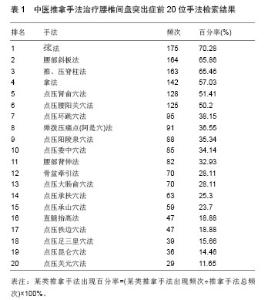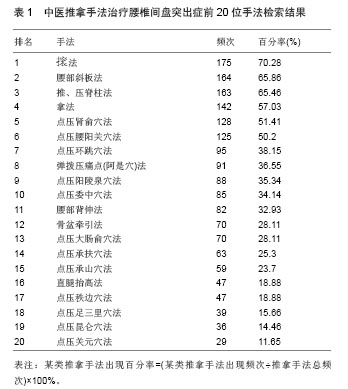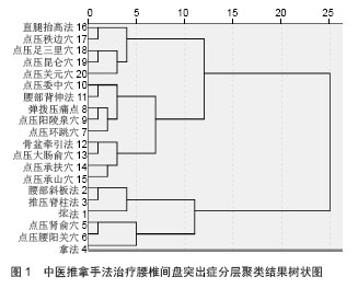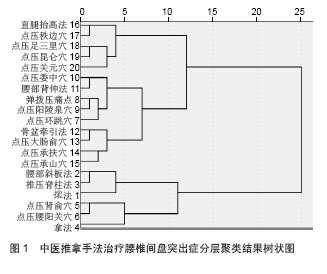| [1]江和明.腰椎间盘突出症治疗进展[J].安徽中医学院学报,2000, 19(6):67-68.
[2]姚共和.腰椎间盘突出症治疗方法的选择[J].中国骨伤,2009, 22(4):247-249.
[3]王国林,李义凯,张美超,等.坐位腰椎旋转手法时腰椎单元内在应力和位移的实时监测[J].中国骨伤,2007,20(3):173-175.
[4]吕立江,袁相龙,汪芳俊,等.杠杆定位整复手法治疗腰椎间盘突出症临床对照试验[J].浙江中医药大学学报,2009,33(4):567-568.
[5]张维斌,曹宇,孙永安,等.手法整复为主治疗腰椎间盘突出症临床对照试验[J].中国骨伤,2008,2l(4):273-275.
[6]张建宏,范建中,彭楠.手法复位治疗急性腰椎间盘突出症的临床研究[J].中国临床康复,2002,6(2):180-181.
[7]国家中医药管理局.中医病症诊断疗效标准[M].南京:南京大学出版社,1994:214.
[8]王之虹.推拿学[M].北京:高等教育出版社,2007:74-107.
[9]何清波,苏丙华,钱元.医学统计学及其软件包[M].上海:上海科学技术文化出版社,2003:285.
[10]米红,张文璋.实用现代统计分析方法与SPSS应用[M].北京:当代中国出版社,2000:221.
[11]杨华娟,杨艳芳.推拿结合牵引治疗124例腰椎间盘突出症的疗效观察[J].按摩与康复医学,2013,4(3):85-87.
[12]袁纯峰.骨伤手法治疗腰椎间盘突出症100例效果观察[J].按摩与康复医学:中旬刊,2011,2(4):84-85.
[13]丁田机.滚揉弹扳法治疗腰椎间盘突出症60例临床观察[J].北京中医,2006,25(2):99-101.
[14]王国才.推拿手法学[M].北京:中国中医药出版社,2007:162.
[15]张继昌.腰椎间盘突出症手法治疗与体会[J].北京中医药大学学报:中医临床版,2010,17(4):43-44.
[16]柯蔚.腰椎间盘突出症手法治疗的适应证探讨[J].中国中医骨伤科杂志,2008,16(5):36-37.
[17]柴铁劬.针灸穴名解[M].北京:科学技术文献出版社,2009:4-5.
[18]占桂平.擦法和一指禅推腰阳关穴治疗腰椎间盘突出症40例观察[J].浙江中医杂志,2012,47(4):276.
[19]翁军.推拿松肌及整骨手法相结合治疗腰椎间盘突出症77例[J].浙江中医药大学学报,2008,32(4):507,509.
[20]孙均重,田端亮,范圣华,等.三步推拿法治疗腰椎间盘突出症的体会[J].中国中医骨伤科杂志,2007,15(6):57-58.
[21]张军,韩磊,宋铁兵,等.腰椎间盘突出症斜扳手法的操作规范[J].中国中医骨伤科杂志,2008,16(5):1,5.
[22]王同山,于杰,罗杰.斜扳手法治疗腰椎间盘突出症[J].中国骨伤, 2006,19(2):126-128.
[23]侯莜魁,董凡,戴克戎,等.斜扳时腰椎后部结构的动态观察和生物力学分析[J].中华骨科杂志,1993,13(1):5l-54.
[24]李祖炳,严东平.两种侧扳法治疗腰椎间盘突出症的疗效比较[J].中医正骨,1999,11(3):15-16.
[25]周红羽,张连仁,李勇.节段定位斜扳法治疗腰椎间盘突出症[J] .中国骨伤,2001,14(5):261-263.
[26]郑立海.四步手法治疗腰椎间盘突出症80例体会[J].中国临床康复,2004,8(20):4041.
[27]白小军,韩艳,于继刚.直腿抬高手法配合牵引治疗腰椎间盘突出症46例[J].陕西中医学院学报,2008,31(2):24-25.
[28]王希.直腿抬高手法治疗腰椎间盘突出症与影像学区域定位的相关性分析[J].中国中医骨伤科杂志,2001,9(1):23-25.
[29]米新,金娣,喻爱敏,等.推拿治疗腰椎间盘突出症56例[J].陕西中医,2012,33(12):1602-1603.
[30]周秀芳,杨通神,黄选玮,等.秩边穴配伍治疗腰椎间盘突出症2000例临床疗效观察[J].四川中医,2007,25(5):99-100.
[31]俞建辉.华佗夹脊穴深刺结合关元灸治疗寒湿型腰椎间盘突出症35例疗效观察[J].中国中医药科技,2013,20(6):665.
[32]刘文,王荣崧,朱树叶,等.循经点按手法治疗腰椎间盘突出症效果分析[J].中医临床研究,2012,4(22):42-43.
[33]张长富.循经点穴配合旋转手法治疗腰椎间盘突出症30例[J].中华中医药杂志,2005,20(10):611-612.
[34]廖炼炼.针刺大杼、委中穴治疗腰椎间盘突出症40例[J].针灸临床杂志,2008,24(9):27.
[35]林志刚,陈水金.拍打委中穴治疗急性腰椎间盘突出症50例[J].中国中医药现代远程教育,2013,11(5):60-61.
[36]姜雷,鲍旭,文锋.过度背伸腰椎手法治疗腰椎间盘突出症临床研究[J].辽宁中医杂志,2001,28(7):421-423.
[37]任立三,白钢田,姚祖进,等.综合手法治疗腰椎间盘突出症[J].国际中医中药杂志,2007,29(6):366-367.
[38]林龙,钱雯.手法治疗腰椎间盘突出症[J].中国疗养医学,2010, 19(2): 149.
[39]刘屹,熊水清. 拨法为主治疗腰椎间盘突出症临床疗效观察[J].中国民族民间医药,2010,19(1):149-150.
[40]王振日,李秀红.四联法治疗腰椎间盘突出症60例[J].光明中医, 2013,28(2):329-330.
[41]钟世镇,李义凯.脊柱推拿的基础与临床[M].北京:人民军医出版社,2001:263.
[42]周翔,王文举,姜东升.四步手法治疗腰间盘突出症100例体会[J].辽宁中医杂志,2006,33(10):1292.
[43]丁国强. 肘推法为主治疗腰椎间盘突出症的疗效观察[J].按摩与康复医学:中旬刊,2010,1(2):51-52.
[44]李连生,于海阔.经穴按摩结合针刺秩边穴综合治疗腰椎间盘突出症200例[J].河北中医,2008,30(8):846-847.
[45]杜世华.扳法为主治疗腰椎间盘突出症134例[J].中国民间疗法, 2013,21(2):21-22.
[46]任立三,马雪东,白钢田.腰椎后伸位牵引治疗腰椎间盘突出症[J].中华物理医学与康复杂志,2005,27(11):687-688.
[47]杨伟伟,郑雯.推拿手法加牵引治疗腰椎间盘突出症120例[J].浙江中医杂志,2008,43(5):279-280.
[48]鲍文,高晓平,吴毅文.复位手法治疗腰椎间盘突出症的近期与远期疗效观察[J].颈腰痛杂志,2010,31(6):442-445.
[49]孙乐蓉,覃东,黄德兰,等.腰椎间盘突出症的综合康复[J].中华物理医学与康复杂志,2005,27(6):324.
[50]顾云伍,韩慧,韦以宗,等.牵引斜扳整脊法治疗腰椎间盘突出症的力学测试[J].中国中医骨伤科杂志,2004,12(1):13-16.
[51]吕立江,金叶道,郑如云,等.不同作用方向的整复手法治疗腰椎间盘突出症临床疗效观察[J].中国骨伤,2009,22(4):255-258.
[52]陈敏生.旋转复位和牵引与单纯牵引治疗腰椎间盘突出症的观察[J].颈腰痛杂志,2008,29(3):283-284. |



